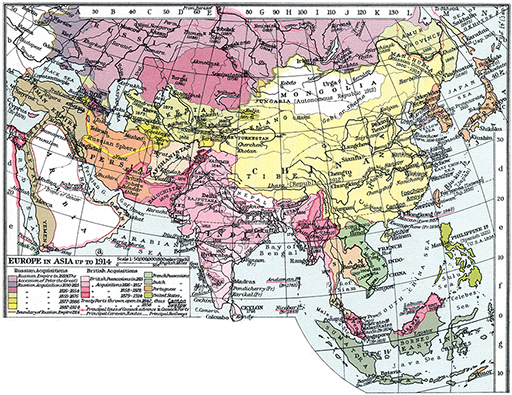International relations: exploring territorial divisions
Introduction
Different forms of international division remain at the heart of some of the most pressing issues of interest to International Relations (IR) today. Figure 1 below shows how two former empires (in this case the British and Russian Empires) expanded across Asia in the nineteenth and twentieth centuries, and demonstrate how the practices of former imperial powers have left a lasting imprint on global politics. A quick glance at a political map of the world shows us how the world is divided along territorial lines. Looking at the roots of such division helps us understand how they came about and how they can be understood in terms of their impact on contemporary international relations.
There are many factors that influence international division in its myriad forms, from basic geographic and climatic divides to the many varied pathways to development chosen by different states and leaders that have led to very different outcomes, and along with it, forms of inequality and division. The current international system, made up of a range of actors including states and international organisations, is only one form of how international relations are organised and understood. Throughout history, what we now see as the ‘international system’ has been organised, understood and experienced in other ways. Indeed, for much of history, different kinds of empire have predominated. The legacy of these historical antecedents continues to influence contemporary international relations between these different actors.
This course will look at how the world is divided territorially and how certain parts of the modern state system came into being. It will then explore the impact of Great Power rivalries and imperialism on the development of the state system we see today, and finish with a case study exploring the development of modern Middle East.
Before you start, take a moment to note down a state with contested or interesting borders that you want to learn more about.
Activity 1
When thinking about this particular state, consider some of the ways in which its borders might have been formed.
- Are there some historical events, such as conflict, or external influences/powers that have shaped how this state evolved into its present day form?
- Perhaps it is or was a major power, or it may have once been a colony of an imperial power?
- Maybe it’s a recent addition to the political map of the world, or that has experienced a change in its borders?
- Perhaps the state in its present form doesn’t fully represent certain groups within it adequately, or maybe it has experienced challenges to its territorial integrity in the past.
You will return to this question at the end of the course to see if there are any aspects that you might want to explore further.

